Deflection Test of Wire-Integrated Steel Deck Plates with Various End Details
Abstract
1. Introduction
2. Design Standards for Deck Plates during Construction
2.1. Design Loads
2.1.1. KDS 21 50 00 [21]
2.1.2. SDI C-2017 [22]
2.2. Deflection Limits
2.2.1. Composite Deck Slab Standard (Proposal) and Commentary [23]
2.2.2. SDI C-2017 [22] and BS EN 1994-1-1 [24]
2.2.3. BS 5950-4 [25]
3. Experimental Program
3.1. Test Specimens
3.2. Loading and Measurement Details
4. Experimental Results and Discussion
4.1. Load Case for Deflection Evaluation
4.2. Deck Plate Load-Deflection Relationship
4.3. Evaluation of Allowable Deck Plate Deflection
4.4. Flexural Stiffness
5. Conclusions
- The three types of end detail included the use of a conventional detail with a vertical bar, a vertical bar and a lattice foot, or only a lattice foot. Regardless of the end details, specimens of the same structural type and lattice truss girder height had similar deflection diagrams, with each specimen exhibiting a similar degree of deflection and flexural stiffness. That is, even when the wire-integrated deck plate had only a lattice foot with no end vertical bar, its performance was equivalent to that of a wire-integrated deck plate with conventional detail.
- In summary, specimens with lattice foot details exhibited similar or higher flexural stiffness than specimens with conventional end details, that is, the lattice foot could transfer gravity loads from wire-integrated deck plates to the supporting structures and could replace vertical bars in practical applications. Therefore, it is considered that a new end detail is used in the construction field, allowing the construction time and cost to be reduced.
Author Contributions
Funding
Institutional Review Board Statement
Informed Consent Statement
Data Availability Statement
Acknowledgments
Conflicts of Interest
References
- Shin, J.; Lee, J.; Lee, Y.; Kim, B. Experimental and numerical investigation on structural performance of steel deck plate bolted with truss girder. Appl. Sci. 2019, 9, 3166. [Google Scholar] [CrossRef]
- Lee, Y.J. Test research of structural safety for steel wire-integrated deck plate system. KSMI 2010, 14, 220–228. (In Korean) [Google Scholar] [CrossRef]
- Choi, I.R.; Lee, G.R.; Jeon, S.H.; Kyung, J.H. Deflection performance evaluation of new deep deck with 300 mm depth during construction loads. J. Korean Soc. Steel Const. 2021, 33, 305–313. [Google Scholar] [CrossRef]
- Kim, S.H.; Hong, J.K.; Kim, D.H. Analytical study on structural performance of wire-integrated steel decks with varied lattice end-support configurations. KSMI 2023, 27, 95–102. (In Korean) [Google Scholar] [CrossRef]
- Heo, I.W.; Han, S.J.; Choi, S.H.; Kim, K.S.; Kim, S.B. Experimental study on structural behavior of double ribbed deep-deck plate under construction loads. J. Korea Inst. Struct. Maint. Insp. 2019, 23, 49–57. (In Korean) [Google Scholar] [CrossRef]
- Jeon, S.H.; Kyung, J.H.; Kim, Y.H.; Choi, S.M.; Yang, I.S. Deflection evaluation of the constructing-load carrying capacity for deep decking floor system reinforced with both ends cap plates. J. Korean Soc. Steel Const. 2015, 27, 155–167. [Google Scholar] [CrossRef]
- Civalek, Ö.; Öztürk, B. Discrete singular convolution algorithm for non-linear transient response of circular plates resting on Winkler-Pasternak elastic foundations with different types of dynamic loading. Indian J. Eng. Mater. Sci. 2009, 16, 259–268. [Google Scholar]
- Kim, S.B.; Kang, M.J.; Hwang, B.C.; Kim, S.S. Structural performance evaluation for steel wire-integrated deck plate according to the diameter of the lattice bar. J. Korean Soc. Hazard Mitig. 2014, 14, 1–9. (In Korean) [Google Scholar] [CrossRef]
- Lee, J.E.; Kim, B.Y.; Jung, B.J. Evaluation of structural safety and economic feasibility for removable steel plate eco deck plate. JAIK 2014, 30, 3–10. (In Korean) [Google Scholar] [CrossRef]
- Kang, M.J.; Kim, S.S. Structural performance evaluation of steel wire-integrated deck plate according to the construction load. JAIK 2015, 31, 3–12. (In Korean) [Google Scholar] [CrossRef]
- Yoo, B.U. A study on structural behavior of composite deck plate using a pre-assembled re-bar truss. KSMI 2006, 10, 129–138. (In Korean) [Google Scholar]
- Liu, R.; Yang, Y.; Zhou, X. Experimental study on fatigue performance of composite beam with steel-plate-concrete composite decks. Constr. Build Mater. 2018, 188, 833–849. [Google Scholar] [CrossRef]
- Xiang, D.; Liu, Y.; Shi, Y.; Xu, X. Vertical shear capacity of steel-concrete composite deck slabs with steel ribs. Eng. Struct. 2022, 262, 114396. [Google Scholar] [CrossRef]
- Zhao, H.; Zhao, J.; Wang, R.; Zhang, W.; Liu, F.; Wu, S. Thermal behavior of composite slabs with closed profiled steel decking and recycled aggregate concrete in fire. Fire Saf. J. 2022, 132, 103637. [Google Scholar] [CrossRef]
- Seo, J.; Hatfield, G.; Kimn, J.H. Probabilistic structural integrity evaluation of a highway steel bridge under unknown trucks. J. Struct. Integr. Maint. 2016, 1, 65–72. [Google Scholar] [CrossRef]
- Bu, Y.; Li, M.; Wei, C.; Cheng, Z.; Cui, C.; Bao, Y. Experimental and analytical studies on flexural behavior of composite bridge decks with orthotropic steel deck and Ultra-High-Performance Concrete (UHPC) slab under negative moment. Eng. Struct. 2023, 274, 115190. [Google Scholar] [CrossRef]
- Cheng, J.; Xu, M.; Xu, H. Mechanical performance analysis and parametric study of double-deck plate-truss composite steel girders of a three-tower four-span suspension bridge. Eng. Struct. 2019, 199, 109648. [Google Scholar] [CrossRef]
- Sebastian, W.M. Bi-Axial behaviours of abraded and rehabilitated FRP decks as anisotropic plates under concentrated wheel loading. Eng. Struct. 2021, 233, 111704. [Google Scholar] [CrossRef]
- Colombani, I.A.; Andrawes, B. A Study of multi-target image-based displacement measurement approach for field testing of bridges. J. Struct. Integr. Maint. 2022, 7, 207–216. [Google Scholar] [CrossRef]
- Moomen, M.; Siddiqui, C. Probabilistic deterioration modeling of bridge component condition with random effects. J. Struct. Integr. Maint. 2022, 7, 151–160. [Google Scholar] [CrossRef]
- KDS 21 50 00; Design Standard of Formwork and Support Bar. Korea Construction Standard Center: Seoul, Republic of Korea, 2022. (In Korean)
- SDI C-2017; Composite Steel Floor Deck-Slabs. American National Standards Institute, and Steel Deck Institute: Washington, DC, USA, 2017.
- AIK. Composite Deck Slab Standard (Proposal) and Commentary; Architectural Institute of Korea: Seoul, Republic of Korea, 1998. (In Korean) [Google Scholar]
- BS EN 1994-1-1; Design of Composite Steel and Concrete Structures General Rules and Rules for Buildings. British Standards Institution: London, UK, 2004.
- BS 5950-4; Structural Use of Steelwork in Building-Part 4: Code of Practice for Design of Composite Slabs with Profiled Steel Sheeting. British Standards Institution: London, UK, 1994.
- Yang, K.H.; Hong, J.K.; Kim, S.H.; Lee, H.J. Structural Performance Evaluation and Design Guideline for End Supports of EXTRA Deck Plate System; Report; Korea Institute for Structural Maintenance and Inspection: Seoul, Republic of Korea, 2022; pp. 1–87. (In Korean) [Google Scholar]

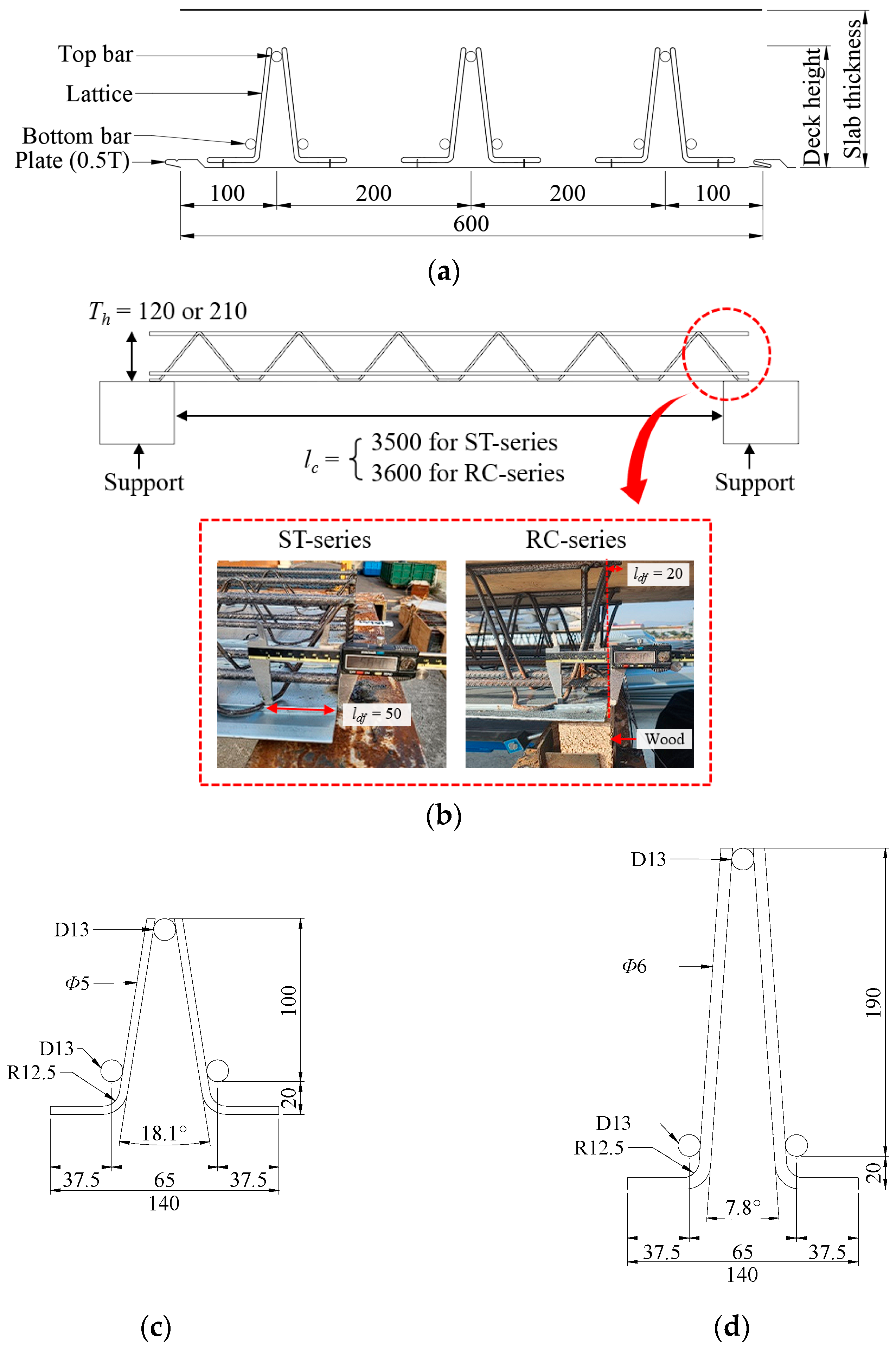


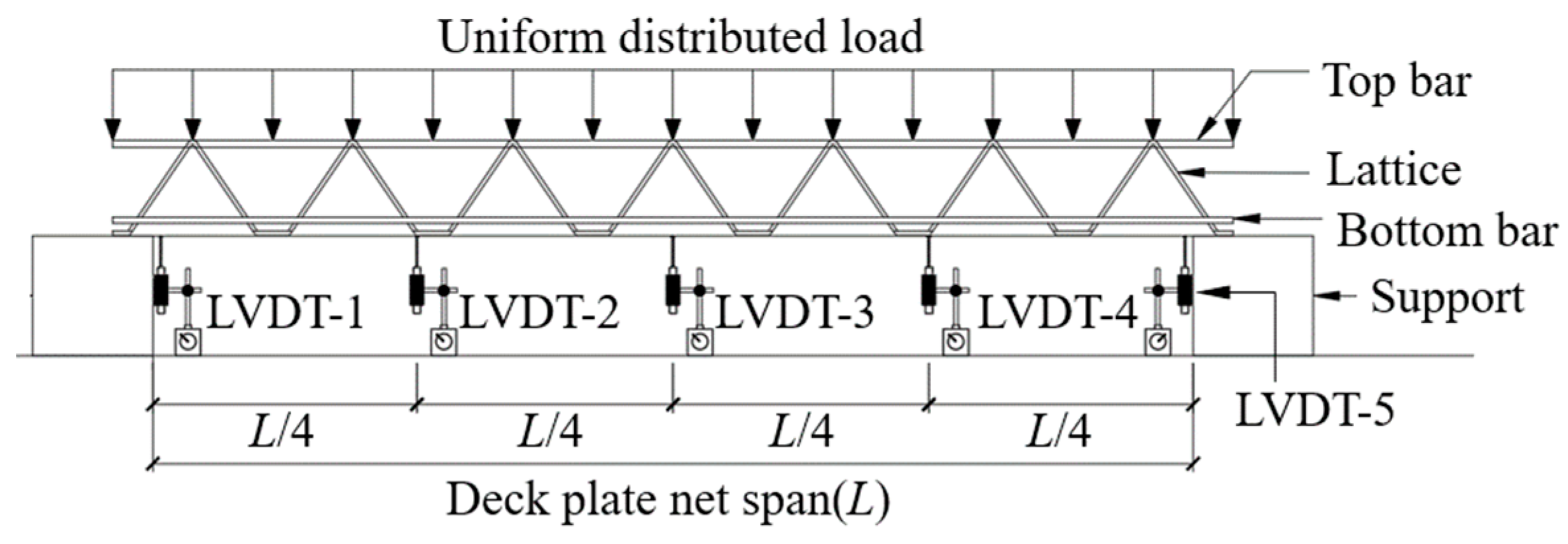
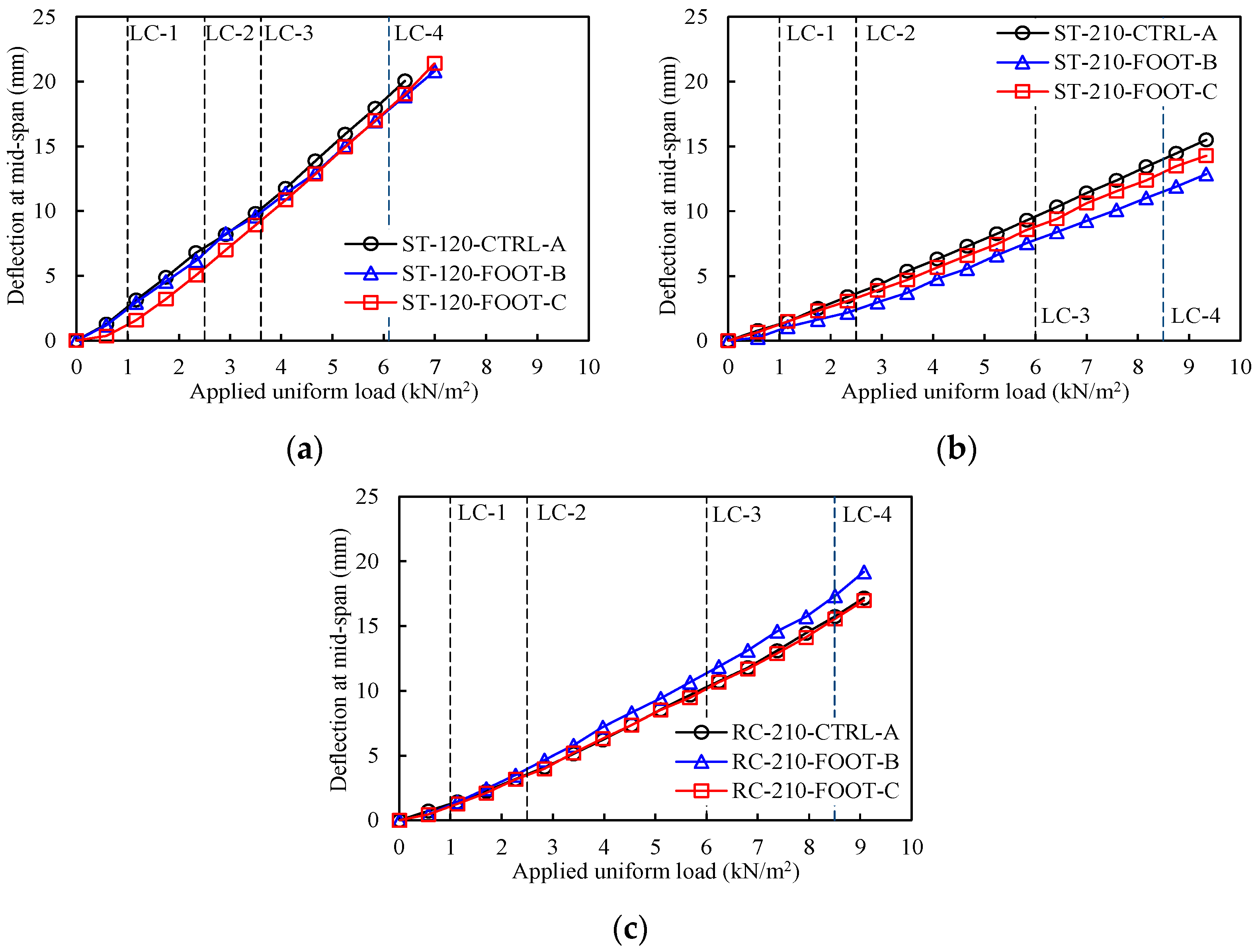
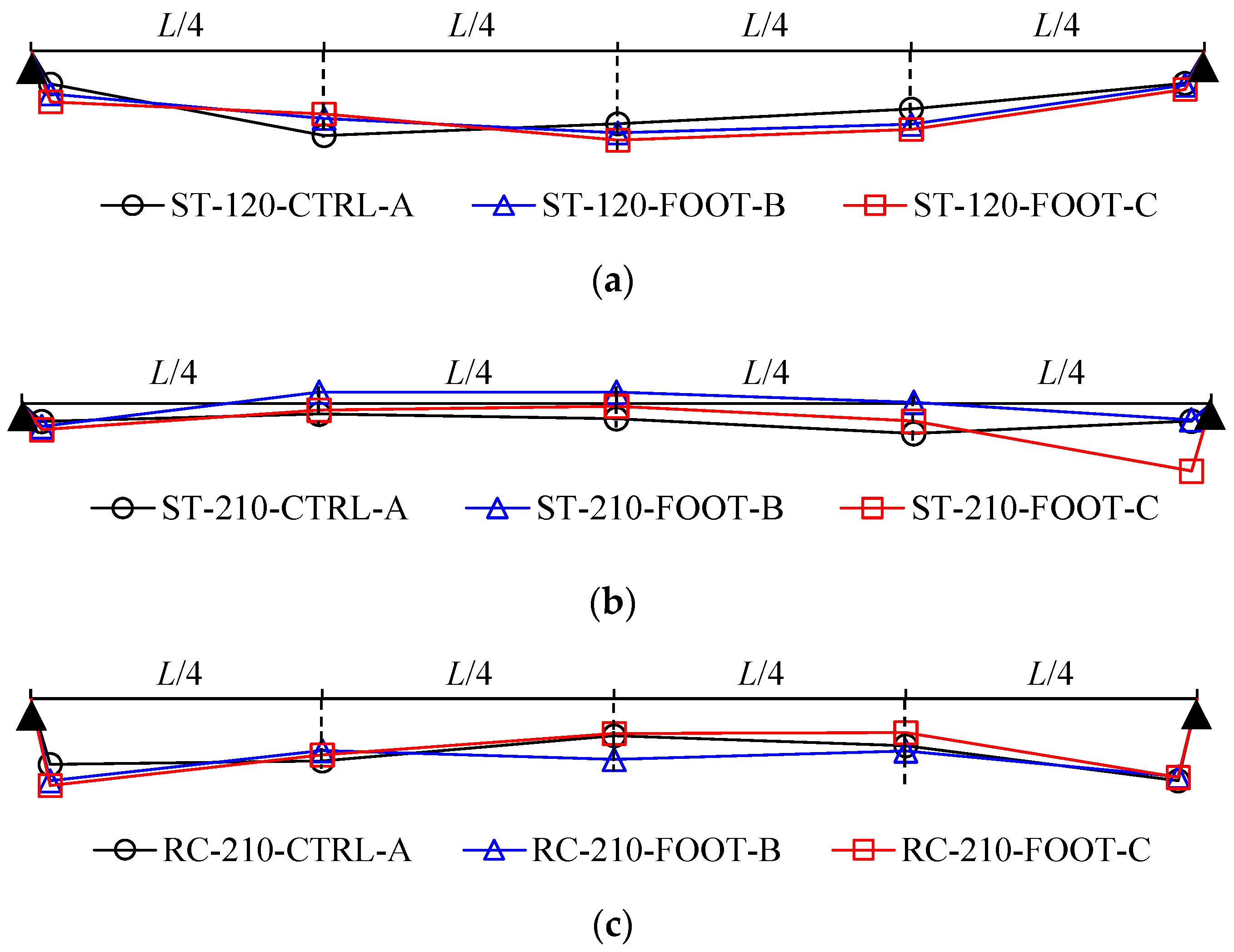
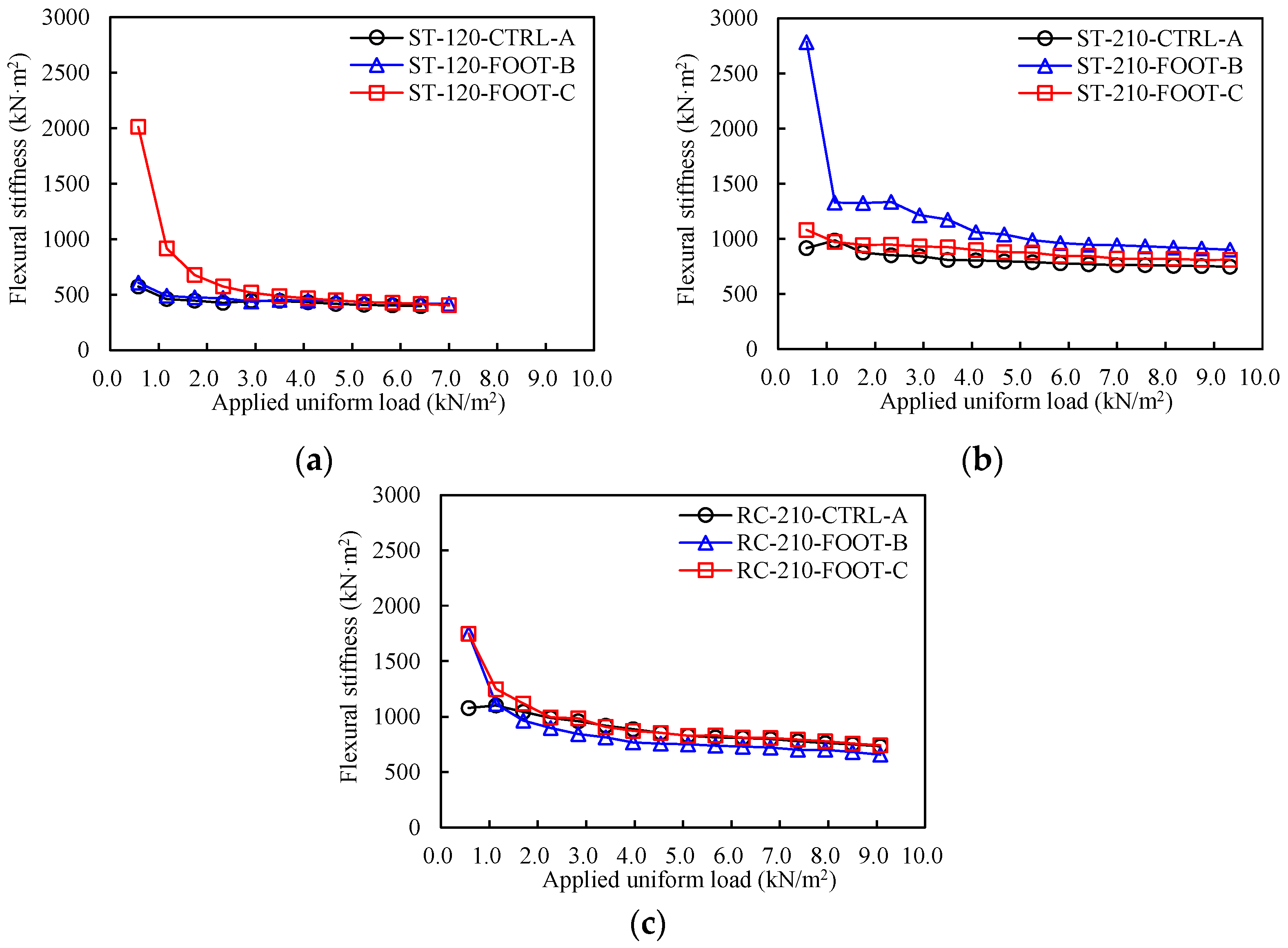
| Group | Specimen ID | End Details 1 | Structure Type | Truss Girder Height (Th) [mm] | Slab Thickness [mm] | Deck Length [mm] | Deck Clear Span (lc) [mm] | Deck Foot Length (ldf) [mm] | Camber [mm] | Top Bar / Bottom Bar | Lattice Bar [mm] |
|---|---|---|---|---|---|---|---|---|---|---|---|
| 1 | ST-120-CTRL-A | A | Steel | 120 | 150 | 3600 | 3500 | 50 | 14.0 | 3-HD13 / 6-HD13 | Φ5 |
| ST-120-FOOT-B | B | ||||||||||
| ST-120-FOOT-C | C | ||||||||||
| 2 | ST-210-CTRL-A | A | 210 | 250 | Φ6 | ||||||
| ST-210-FOOT-B | B | ||||||||||
| ST-210-FOOT-C | C | ||||||||||
| 3 | RC-210-CTRL-A | A | RC | 210 | 250 | 3740 | 3600 | 20 | 14.8 | ||
| RC-210-FOOT-B | B | ||||||||||
| RC-210-FOOT-C | C |
| Slab Thickness [mm] | Construction Load [kN/m2] | Dead Load (Concrete) [kN/m2] | Total Load [kN/m2] |
|---|---|---|---|
| 150 | 2.5 | 3.6 | 6.1 |
| 250 | 6.0 | 8.5 |
| Loading Step | Number of Load Bags | Total Weight of Load Bags [kg] | Load per Unit Area [kN/m2] | |
|---|---|---|---|---|
| Steel Beam | RC Beam | |||
| Step-1 | 5 | 125 | 0.58 | 0.57 |
| Step-2 | 10 | 250 | 1.17 | 1.13 |
| Step-3 | 15 | 375 | 1.75 | 1.70 |
| Step-4 | 20 | 500 | 2.33 | 2.27 |
| Step-5 | 25 | 625 | 2.92 | 2.84 |
| Step-6 | 30 | 750 | 3.50 | 3.40 |
| Step-7 | 35 | 875 | 4.08 | 3.97 |
| Step-8 | 40 | 1000 | 4.67 | 4.54 |
| Step-9 | 45 | 1125 | 5.25 | 5.10 |
| Step-10 | 50 | 1250 | 5.83 | 5.67 |
| Step-11 | 55 | 1375 | 6.42 | 6.24 |
| Step-12 | 60 | 1500 | 7.00 | 6.81 |
| Step-13 | 65 | 1625 | 7.58 | 7.37 |
| Step-14 | 70 | 1750 | 8.17 | 7.94 |
| Step-15 | 75 | 1875 | 8.75 | 8.51 |
| Step-16 | 80 | 2000 | 9.33 | 9.07 |
| Load Cases | Load | Load Per Square Meter [kN/m2] | |
|---|---|---|---|
| Slab Thickness 150 mm (Lattice Truss Girder 120 mm) | Slab Thickness 250 mm (Lattice Truss Girder 210 mm) | ||
| LC-1 | wlc | 1.0 | 1.0 |
| LC-2 | wlc | 2.5 | 2.5 |
| LC-3 | wdc | 3.6 | 6.0 |
| LC-4 | wdc + wdd | 6.1 | 8.5 |
| Group | Specimen ID | Deflection at Mid-Span [mm] | |||||||||||||||
|---|---|---|---|---|---|---|---|---|---|---|---|---|---|---|---|---|---|
| Step-1 | Step-2 | Step-3 | Step-4 | Step-5 | Step-6 | Step-7 | Step-8 | Step-9 | Step-10 | Step-11 | Step-12 | Step-13 | Step-14 | Step-15 | Step-16 | ||
| Load per Unit Area [kN/m2] | 0.58 | 1.17 | 1.75 | 2.33 | 2.92 | 3.50 | 4.08 | 4.67 | 5.25 | 5.83 | 6.42 | 7.00 | 7.58 | 8.17 | 8.75 | 9.33 | |
| 1 | ST-120-CTRL-A | 1.26 | 3.14 | 4.88 | 6.79 | 8.19 | 9.82 | 11.77 | 13.87 | 15.95 | 17.95 | 20.07 | - | - | - | - | - |
| ST-120-FOOT-B | 1.19 | 2.95 | 4.57 | 6.18 | 8.27 | 9.60 | 11.37 | 12.94 | 15.03 | 16.95 | 18.89 | 20.82 | - | - | - | - | |
| ST-120-FOOT-C | 0.36 | 1.58 | 3.21 | 5.05 | 7.00 | 8.93 | 10.87 | 12.87 | 14.96 | 17.00 | 19.03 | 21.43 | - | - | - | - | |
| 2 | ST-210-CTRL-A | 0.79 | 1.47 | 2.48 | 3.40 | 4.29 | 5.37 | 6.30 | 7.28 | 8.27 | 9.30 | 10.33 | 11.42 | 12.39 | 13.44 | 14.46 | 15.51 |
| ST-210-FOOT-B | 0.26 | 1.09 | 1.64 | 2.17 | 2.98 | 3.70 | 4.78 | 5.57 | 6.60 | 7.54 | 8.41 | 9.24 | 10.09 | 11.01 | 11.91 | 12.86 | |
| ST-210-FOOT-C | 0.67 | 1.49 | 2.30 | 3.06 | 3.89 | 4.70 | 5.65 | 6.59 | 7.46 | 8.55 | 9.42 | 10.62 | 11.54 | 12.39 | 13.47 | 14.28 | |
| Load per Unit Area [kN/m2] | 0.57 | 1.13 | 1.70 | 2.27 | 2.84 | 3.40 | 3.97 | 4.54 | 5.10 | 5.67 | 6.24 | 6.81 | 7.37 | 7.94 | 8.51 | 9.07 | |
| 3 | RC-210-CTRL-A | 0.73 | 1.43 | 2.26 | 3.19 | 4.10 | 5.14 | 6.21 | 7.37 | 8.55 | 9.68 | 10.73 | 11.80 | 13.11 | 14.45 | 15.74 | 17.17 |
| RC-210-FOOT-B | 0.45 | 1.41 | 2.45 | 3.50 | 4.67 | 5.80 | 7.19 | 8.32 | 9.43 | 10.66 | 11.87 | 13.12 | 14.59 | 15.72 | 17.33 | 19.19 | |
| RC-210-FOOT-C | 0.45 | 1.26 | 2.11 | 3.17 | 3.99 | 5.20 | 6.31 | 7.37 | 8.54 | 9.48 | 10.67 | 11.70 | 12.88 | 14.14 | 15.55 | 16.98 | |
| Group | Specimen ID | Camber [mm] (1) | Measurement Deflection [mm] | Maximum Deflection [mm] ((1) + (2)) | Decision | ||
|---|---|---|---|---|---|---|---|
| LC-3 | LC-4 (2) | Allowable Deflection [mm] | OK/NG | ||||
| 1 | ST-120-CTRL-A | −14.0 | 9.8 | 20.1 | 6.1 | 19.0 | OK |
| ST-120-FOOT-B | 9.6 | 18.9 | 4.9 | OK | |||
| ST-120-FOOT-C | 8.9 | 19.0 | 5.0 | OK | |||
| 2 | ST-210-CTRL-A | 10.3 | 14.5 | 0.5 | OK | ||
| ST-210-FOOT-B | 8.4 | 11.9 | −2.1 | OK | |||
| ST-210-FOOT-C | 9.4 | 13.5 | −0.5 | OK | |||
| 3 | RC-210-CTRL-A | −14.8 | 10.7 | 15.7 | 0.9 | OK | |
| RC-210-FOOT-B | 11.9 | 17.3 | 2.5 | OK | |||
| RC-210-FOOT-C | 10.7 | 15.6 | 0.8 | OK | |||
Disclaimer/Publisher’s Note: The statements, opinions and data contained in all publications are solely those of the individual author(s) and contributor(s) and not of MDPI and/or the editor(s). MDPI and/or the editor(s) disclaim responsibility for any injury to people or property resulting from any ideas, methods, instructions or products referred to in the content. |
© 2023 by the authors. Licensee MDPI, Basel, Switzerland. This article is an open access article distributed under the terms and conditions of the Creative Commons Attribution (CC BY) license (https://creativecommons.org/licenses/by/4.0/).
Share and Cite
Lee, H.-J.; Yang, K.-H.; Kim, S.; Hong, J.-K.; Kim, D.-H.; Mun, J.-H. Deflection Test of Wire-Integrated Steel Deck Plates with Various End Details. Materials 2023, 16, 2251. https://doi.org/10.3390/ma16062251
Lee H-J, Yang K-H, Kim S, Hong J-K, Kim D-H, Mun J-H. Deflection Test of Wire-Integrated Steel Deck Plates with Various End Details. Materials. 2023; 16(6):2251. https://doi.org/10.3390/ma16062251
Chicago/Turabian StyleLee, Hye-Ji, Keun-Hyeok Yang, Sanghee Kim, Jong-Kook Hong, Deung-Hwan Kim, and Ju-Hyun Mun. 2023. "Deflection Test of Wire-Integrated Steel Deck Plates with Various End Details" Materials 16, no. 6: 2251. https://doi.org/10.3390/ma16062251
APA StyleLee, H.-J., Yang, K.-H., Kim, S., Hong, J.-K., Kim, D.-H., & Mun, J.-H. (2023). Deflection Test of Wire-Integrated Steel Deck Plates with Various End Details. Materials, 16(6), 2251. https://doi.org/10.3390/ma16062251









